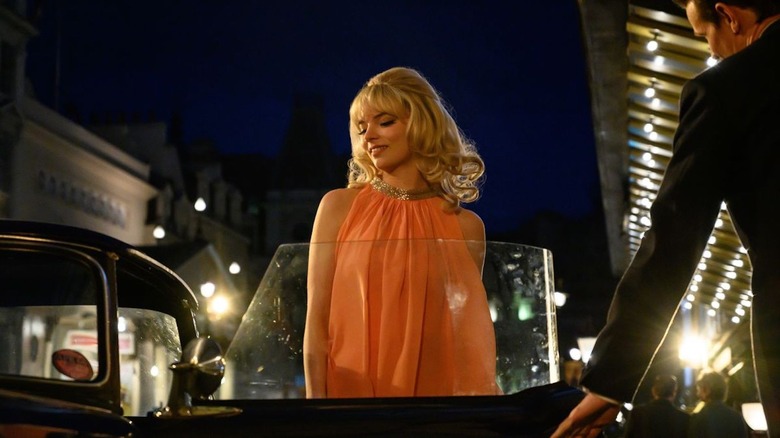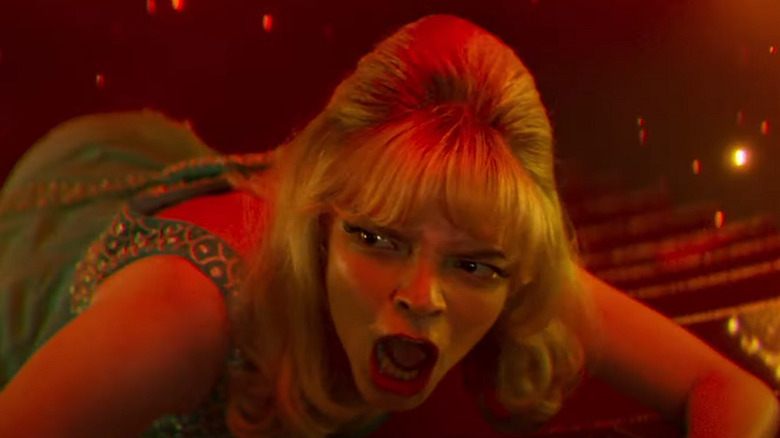Last Night In Soho Ending Explained: Nostalgia Is A Killer
Edgar Wright's "Last Night in Soho," a shot-across-the-bow warning of the dangers of nostalgia, centers on young hopeful fashion student Eloise "Ellie" Turner (Thomasin McKenzie). Eloise is both literally and figuratively haunted by the past. In one sense, she's a girl out of time — ill at ease in her own contemporary era and idealizing 1960s London with all its glamorous extravagances. On the other hand, she's literally haunted by the ghostly but loving visage of her mother, who long ago was lost to suicide and who had suffered some form of schizophrenia (though we don't know its precise manifestations or the specifics of why she committed suicide). Ever since, Ellie sees her everywhere. When Ellie moves to London in an attempt to make it in fashion school and the big city, she quickly finds herself out of sorts with an inconsiderate roommate and present-day party culture. Ellie opts instead to live in the top floor of a relatively isolated flat, lorded over by the stern landlady Ms. Collins (Dame Diana Rigg). Things change soon when Ellie turns in for the night, finding herself transported into the body of 1960s It Girl hopeful Sandie (Anya Taylor-Joy), a young woman whose journey becomes more treacherous the longer Ellie experiences it.
It's a film full of some pretty big twists and turns, surreal experiences, and a complex final scene that has clear answers but which may not be readily apparent. With "Last Night in Soho" in theaters, lets take a look at the film's stunning ending. We can't dig into that ending without a thorough look at how we get there, so you should be warned: there are major spoilers ahead.
Turn On, Tune In, Drop Out of Time
Ellie discovers that Sandie's time in London wasn't all glamor and roses, with the career promises of Sandie's manager Jack (Matt Smith) gradually devolving into forced prostitution. One particularly fateful night sees Ellie witness what she thinks is Sandie's murder. From that moment on, Ellie starts a frantic search for the truth of this supposed past murder while facing increasing visitations from the ghosts of what seem to be Sandie's many predatory lovers. The visitations build to a crescendo, causing Ellie to begin to doubt her own sanity until she sees the truth: Sandie wasn't murdered that night — she killed Jack in self defense, never to be seen again. He's buried in the floorboards of the very house (indeed the very room, presumably) that Eloise stays in ... and then proceeded to kill innumerable other men, taking them to her upstairs room and killing them one by one. When Ellie, fearing the collapse of her own sanity, returns to grab her things and leave London for good, we learn the rest of the truth: the stern landlady Ms. Collins WAS Sandie (whose real name was Alex), and the horde of faceless male ghosts are her myriad victims reaching out to Ellie for help.
The clues in advance of the reveal are sparse but consistent. The repeated trauma of what befell Sandie (the idealistic chosen stage name of Alexandra) became too much for Alex to bear. Before becoming a quite prolific serial killer we see her increasingly disassociate, giving multiple other names for herself to the various Johns forced upon her, and even denying the help of local cop Lindsay (played in youth by Sam Claflin, and later seen as Terence Stamp's mysterious Silver Haired Gentleman). The latter of which is used as a red herring, as we follow Ellie in mistakenly believing him to be the older Jack instead of an ex-cop of the era. It isn't directly implied that Alex/Sandie's personality truly fractures, but the trauma does take her idealistic Sandie persona away until she begins to take lives. As Lindsay puts it in explanation, "Alex killed Sandie."
While Ellie's ability to connect to Sandie's past and see her specter in the present aren't entirely explained, Ellie's ability to see the world through Sandie's eyes and later see her ghost may be either a ghastly projection by Sandie's many victims, or they may even be as simple as a side effect of a young woman with Ellie's abilities being surrounded by a sea of death literally under her feet and in Ms. Collins' own heart. The wave of murders also make it clear why "Ms. Collins" chose to live so long in that house, eventually coming to own it ... how could she move with a sea of bones beneath the floorboards? In a sense, the wave of misogynist men that trapped her in early life also trapped her in later life. When Ms. Collins' catches Ellie early on with John (Michael Ajao) after a night on the town, she claims she could have killed him ... and it turns out she means it. (That the character's name is literally John, and she has a long history of killing "Johns," is in context a pretty blunt joke).
What's in a Name?
By the time Ellie realizes serial-killer-Alex is Ms. Collins, the latter already suspected her secret was or would soon be up, because of a police inquiry into Sandie's long-ago disappearance. Ellie realizes this too late, having already drank poisoned tea from the latter. John rings the doorbell and is promptly stabbed by Ms. Collins, and the drugged Ellie accidentally starts a fire while attempting to escape the murderous landlady. She's chased up the stairway as the fire spreads, while the various ghosts of faceless men pick a fine time to haunt the pair and start to emerge once more. Seeing the end, Ms. Collins starts to attempt to cut her own throat, only to be stopped by Ellie. Ellie and John get rescued in the nick of time from the flames, while Ms. Collins opts to die in the fire, finally consumed by the house that had long become her prison (our last image is of her surrounded by flames, resigned to her fate ... there's really no way she could have survived). There's no grand speech explaining why Ms. Collins chose to die in the fire, but her long stilted life as she knew it was indeed over. The questions around her string of murders were gaining increasing police attention, and the fire would certainly reveal the horde of bones buried inside the house.
The film follows up with Ellie and John following the events of the burning house, both happy, healthy, and together. A confident Ellie is displaying a series of 1960s fashion pieces she designed to considerable acclaim. She clearly hasn't left school or London, and we can infer by the well-slept-looking Ellie that the parade of frightening ghosts and nightly tours of seedy 1960s London have stopped. The final shot shows Ellie peering proudly into a mirror, to be visited once again by the warm visage of her mother (Amieé Cassettari) followed by a surprise appearance by a familiar face: Sandie, once again looking happy and beaming in her peak 60s grandeur.
The Abyss of 1960s London Also Gazes Into You
The sudden appearance of a happy Sandie is a big surprising for an ending, given the preceding conflict and tragic end of the woman who once went by that name. Indeed, it could mean a number of potential things, so we'll break down the ambiguous possibilities one by one. First, she could be merely seeing Ms. Collins' spirit once again restored and whole, returned to her most idealistic and positive state. We know Ellie can see spirits, and Sandie's presence in the film's final moments follows a joyous moment for Ellie, followed by her mother's happy visitation. The positive tone overall could be speaking to that most optimistic potential outcome.
While that's the most pleasant of the potential meanings, a darker interpretation could be that there's some remnant of Sandie still in Ellie, perhaps a side effect of spending so long entwined in Sandie's life and trauma. In this regard, it could be seen as an ominous warning for Ellie not to repeat her earlier naive nostalgic blindness when a similar starry-eyed optimism fueled Sandie's downward descent. This more negative interpretation recalls Nietzsche's classic warning:
"He who fights with monsters might take care lest he thereby become a monster. And when you gaze long into an abyss the abyss also gazes into you."
Ellie's success notwithstanding, Sandie's tragic end and surprising reappearance may portend a warning to be on guard lest a similar tragic end befall our protagonist fashionista.
A final possible interpretation follows the film's own premise (and takes a decidedly literal interpretation of that same Nietzsche quote). Just as Ellie toured Sandie's 1960s life as a passenger visible only in mirrors, so, too, may 1960s Sandie be a passenger in our own day who experiences the world through Ellie's actions. In this interpretation, the appearance could be the direct reversal of how Ellie saw the 1960's via Sandie's eyes. While this appearance is the most conceptually shocking in some ways, it's also the interpretation that fits with the film's unique logic in the most poetically circular way. Moreover, in some ways it opens the film up to its most optimistic potential outcome. Just as the experience of 1960s Sandie's fall from grace put Ellie in a downward spiral, so too may experiencing Ellie's more modern, grounded one put 1960s Sandie on an upward path. It may even prevent that descent entirely, saving her life and the lives of the men she killed. Of course, we don't know for sure ... but here's to hoping.



